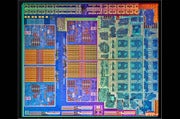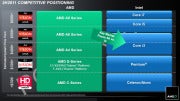Lewis
Member
- Aug 5, 2005
- 15,483
- 621
AMD A-Series Chips Promises Faster Graphics and Longer Battery Life Jun 13, 2011 9:01 PM

Today, AMD is taking the wraps off its Fusion A-Series processors. Whereas the Fusion chips that launched earlier this year were designed to compete with Intel's Atom CPU in netbooks and very-low-cost ultraportable PCs, the A-Series targets midsize mainstream laptops. The CPU cores aren't likely to stand up to Intel's "Sandy Bridge" second-generation Core processors, but the new chips promise superior graphics performance and battery life in laptops priced at between $500 and $1000.
In early January 2011, AMD shipped the first of its Fusion line of processors: the E-Series and the C-Series. Based on the same chip design, those products have been popular and highly acclaimed in premium netbooks and low-end ultraportable laptops, providing CPU and graphics performance that eats Intel's Atom for lunch at competitive costs. AMD calls these processors APUs, or Accelerated Processing Units, to call attention to their ability to offload some parallel processing tasks to the DirectX 11-capable graphics portion of the chip.
Well-received though they have been, the E- and C-Series chips aren't the Fusion processors to get excited about. The real deal is the chip code-named Llano, which has now launched as the A-Series APU. These new chips are meant for midpriced and midsize laptops. Delays in GlobalFoundries' 32-nanometer manufacturing held up the launch of Llano, but now it's finally ready to see the light of day. The chips use a smaller manufacturing process than the 40nm process (produced by TSMC) used by the E- and C-Series, and they include more-powerful hardware and a handful of unique new features.
We don't yet have laptops equipped with A-Series APUs to test, but the new chips look impressive on paper. For impatient statistics fans, here's a rundown of the different laptop model numbers and their specs. (Though it designed the A-Series chips primarily for laptops, AMD will also produce desktop A-Series models that use more power and run slightly faster.
 AMD A-Series models.
AMD A-Series models.
The A-Series CPU Cores
 AMD A-Series CPU core block diagram.The CPU in the A-Series is a modified "Stars" core, the same CPU core found in AMD's Phenom II processor. The chip contains four cores with 4MB of L2 cache, though two of the cores (and half the L2 cache) will be disabled in the A4 models. They're fused off at the fabrication plant, so don't plan on using a software hack to reenable all four cores. This is often done as a way for the manufacturer to salvage chips that would otherwise be considered faulty. Later this year, a new smaller version of the chip with only two CPU cores will hit the market, allowing AMD to market more-cost-effective A4 models and even some new E-Series models. AMD has tweaked the CPU core design, resulting in about a 6 percent improvement in IPC (Instructions Per Clock) over what you'd find in a Phenom II. Still, the clock speeds aren't terribly high, ranging from 1.4GHz to 2.1GHz. Like Intel's Turbo Boost, AMD's Turbo Core technology will automatically step up the clock speed when additional processing power is needed, adding 400MHz to 900MHz for demanding applications as long as the temperature and power draw don't get too high.
AMD A-Series CPU core block diagram.The CPU in the A-Series is a modified "Stars" core, the same CPU core found in AMD's Phenom II processor. The chip contains four cores with 4MB of L2 cache, though two of the cores (and half the L2 cache) will be disabled in the A4 models. They're fused off at the fabrication plant, so don't plan on using a software hack to reenable all four cores. This is often done as a way for the manufacturer to salvage chips that would otherwise be considered faulty. Later this year, a new smaller version of the chip with only two CPU cores will hit the market, allowing AMD to market more-cost-effective A4 models and even some new E-Series models. AMD has tweaked the CPU core design, resulting in about a 6 percent improvement in IPC (Instructions Per Clock) over what you'd find in a Phenom II. Still, the clock speeds aren't terribly high, ranging from 1.4GHz to 2.1GHz. Like Intel's Turbo Boost, AMD's Turbo Core technology will automatically step up the clock speed when additional processing power is needed, adding 400MHz to 900MHz for demanding applications as long as the temperature and power draw don't get too high.
From a CPU performance perspective, we don't expect the A-Series to outperform Intel's second-generation Core processors. The advantages for AMD are likely to be in better graphics performance, in enabling GPU accelerated software, and in aggressive power management.
The A-Series GPU
 A-Series GPU specs, by model.The graphics side of the Llano chip is where things get interesting. As it did with the E- and C-Series APUs, AMD is leveraging the design of the latest Radeon 6000 graphics chips. In fact, the portion of the chip devoted to graphics is nearly half--far greater than the comparable part on Intel's chips. The low-end A4 dual-core chips will enable just 240 graphics cores, the quad-core A6 enables 320 cores, and the A8 uses 400 graphics cores. AMD promises graphics performance in the range of 30 to 50 percent higher than Intel's latest Sandy Bridge processors, and in some cases even better.
A-Series GPU specs, by model.The graphics side of the Llano chip is where things get interesting. As it did with the E- and C-Series APUs, AMD is leveraging the design of the latest Radeon 6000 graphics chips. In fact, the portion of the chip devoted to graphics is nearly half--far greater than the comparable part on Intel's chips. The low-end A4 dual-core chips will enable just 240 graphics cores, the quad-core A6 enables 320 cores, and the A8 uses 400 graphics cores. AMD promises graphics performance in the range of 30 to 50 percent higher than Intel's latest Sandy Bridge processors, and in some cases even better.
What the company is really banking on, however, is the ability of the graphics portion of the chip to handle strenuous general computing tasks. This is often called GP-GPU (General Purpose GPU) computing. Programming interfaces like OpenCL and DirectCompute allow developers to tap into the massive parallel number-crunching power of today's graphics chips to run particularly difficult tasks much faster. GP-GPU computing is especially well suited to video editing and encoding, image manipulation, physics, scientific computing, audio manipulation, and similar processor-intensive tasks. So far, few developers are using programmable GPUs for these non-3D-graphics tasks, but the number is growing and AMD is working hard to build the ecosystem.
Of course, the GPU matters in a lot of other ways, too. Modern Web browsers such as Internet Explorer 9, Firefox 4, and Chrome use the GPU to accelerate the way they draw Web pages, especially those that use new HTML5 functions. While the performance and robustness of such GPU acceleration varies from one browser to the next, all three are striving to do more with the GPU. In a modern PC, the GPU is also where the video decoding hardware resides, and the video hardware in AMD's latest GPUs is second to none. In our experience, it decodes more formats with better image quality than other integrated graphics chips do.
The A-Series APUs can also be paired with discrete Radeon graphics chips in what AMD calls Dual Graphics mode. Instead of switching between the integrated graphics chips and the discrete ones, designers can arrange for them to work together for improved performance. There are limits, of course. Only certain Radeon mobile discrete graphics models will work for Dual Graphics mode, and it doesn't exactly double your performance. AMD claims that Dual Graphics mode adds about 30 to 50 percent higher performance over the discrete GPU working alone.

Today, AMD is taking the wraps off its Fusion A-Series processors. Whereas the Fusion chips that launched earlier this year were designed to compete with Intel's Atom CPU in netbooks and very-low-cost ultraportable PCs, the A-Series targets midsize mainstream laptops. The CPU cores aren't likely to stand up to Intel's "Sandy Bridge" second-generation Core processors, but the new chips promise superior graphics performance and battery life in laptops priced at between $500 and $1000.
In early January 2011, AMD shipped the first of its Fusion line of processors: the E-Series and the C-Series. Based on the same chip design, those products have been popular and highly acclaimed in premium netbooks and low-end ultraportable laptops, providing CPU and graphics performance that eats Intel's Atom for lunch at competitive costs. AMD calls these processors APUs, or Accelerated Processing Units, to call attention to their ability to offload some parallel processing tasks to the DirectX 11-capable graphics portion of the chip.
Well-received though they have been, the E- and C-Series chips aren't the Fusion processors to get excited about. The real deal is the chip code-named Llano, which has now launched as the A-Series APU. These new chips are meant for midpriced and midsize laptops. Delays in GlobalFoundries' 32-nanometer manufacturing held up the launch of Llano, but now it's finally ready to see the light of day. The chips use a smaller manufacturing process than the 40nm process (produced by TSMC) used by the E- and C-Series, and they include more-powerful hardware and a handful of unique new features.
We don't yet have laptops equipped with A-Series APUs to test, but the new chips look impressive on paper. For impatient statistics fans, here's a rundown of the different laptop model numbers and their specs. (Though it designed the A-Series chips primarily for laptops, AMD will also produce desktop A-Series models that use more power and run slightly faster.

The A-Series CPU Cores
 AMD A-Series CPU core block diagram.The CPU in the A-Series is a modified "Stars" core, the same CPU core found in AMD's Phenom II processor. The chip contains four cores with 4MB of L2 cache, though two of the cores (and half the L2 cache) will be disabled in the A4 models. They're fused off at the fabrication plant, so don't plan on using a software hack to reenable all four cores. This is often done as a way for the manufacturer to salvage chips that would otherwise be considered faulty. Later this year, a new smaller version of the chip with only two CPU cores will hit the market, allowing AMD to market more-cost-effective A4 models and even some new E-Series models. AMD has tweaked the CPU core design, resulting in about a 6 percent improvement in IPC (Instructions Per Clock) over what you'd find in a Phenom II. Still, the clock speeds aren't terribly high, ranging from 1.4GHz to 2.1GHz. Like Intel's Turbo Boost, AMD's Turbo Core technology will automatically step up the clock speed when additional processing power is needed, adding 400MHz to 900MHz for demanding applications as long as the temperature and power draw don't get too high.
AMD A-Series CPU core block diagram.The CPU in the A-Series is a modified "Stars" core, the same CPU core found in AMD's Phenom II processor. The chip contains four cores with 4MB of L2 cache, though two of the cores (and half the L2 cache) will be disabled in the A4 models. They're fused off at the fabrication plant, so don't plan on using a software hack to reenable all four cores. This is often done as a way for the manufacturer to salvage chips that would otherwise be considered faulty. Later this year, a new smaller version of the chip with only two CPU cores will hit the market, allowing AMD to market more-cost-effective A4 models and even some new E-Series models. AMD has tweaked the CPU core design, resulting in about a 6 percent improvement in IPC (Instructions Per Clock) over what you'd find in a Phenom II. Still, the clock speeds aren't terribly high, ranging from 1.4GHz to 2.1GHz. Like Intel's Turbo Boost, AMD's Turbo Core technology will automatically step up the clock speed when additional processing power is needed, adding 400MHz to 900MHz for demanding applications as long as the temperature and power draw don't get too high. From a CPU performance perspective, we don't expect the A-Series to outperform Intel's second-generation Core processors. The advantages for AMD are likely to be in better graphics performance, in enabling GPU accelerated software, and in aggressive power management.
The A-Series GPU
 A-Series GPU specs, by model.The graphics side of the Llano chip is where things get interesting. As it did with the E- and C-Series APUs, AMD is leveraging the design of the latest Radeon 6000 graphics chips. In fact, the portion of the chip devoted to graphics is nearly half--far greater than the comparable part on Intel's chips. The low-end A4 dual-core chips will enable just 240 graphics cores, the quad-core A6 enables 320 cores, and the A8 uses 400 graphics cores. AMD promises graphics performance in the range of 30 to 50 percent higher than Intel's latest Sandy Bridge processors, and in some cases even better.
A-Series GPU specs, by model.The graphics side of the Llano chip is where things get interesting. As it did with the E- and C-Series APUs, AMD is leveraging the design of the latest Radeon 6000 graphics chips. In fact, the portion of the chip devoted to graphics is nearly half--far greater than the comparable part on Intel's chips. The low-end A4 dual-core chips will enable just 240 graphics cores, the quad-core A6 enables 320 cores, and the A8 uses 400 graphics cores. AMD promises graphics performance in the range of 30 to 50 percent higher than Intel's latest Sandy Bridge processors, and in some cases even better. What the company is really banking on, however, is the ability of the graphics portion of the chip to handle strenuous general computing tasks. This is often called GP-GPU (General Purpose GPU) computing. Programming interfaces like OpenCL and DirectCompute allow developers to tap into the massive parallel number-crunching power of today's graphics chips to run particularly difficult tasks much faster. GP-GPU computing is especially well suited to video editing and encoding, image manipulation, physics, scientific computing, audio manipulation, and similar processor-intensive tasks. So far, few developers are using programmable GPUs for these non-3D-graphics tasks, but the number is growing and AMD is working hard to build the ecosystem.
Of course, the GPU matters in a lot of other ways, too. Modern Web browsers such as Internet Explorer 9, Firefox 4, and Chrome use the GPU to accelerate the way they draw Web pages, especially those that use new HTML5 functions. While the performance and robustness of such GPU acceleration varies from one browser to the next, all three are striving to do more with the GPU. In a modern PC, the GPU is also where the video decoding hardware resides, and the video hardware in AMD's latest GPUs is second to none. In our experience, it decodes more formats with better image quality than other integrated graphics chips do.
The A-Series APUs can also be paired with discrete Radeon graphics chips in what AMD calls Dual Graphics mode. Instead of switching between the integrated graphics chips and the discrete ones, designers can arrange for them to work together for improved performance. There are limits, of course. Only certain Radeon mobile discrete graphics models will work for Dual Graphics mode, and it doesn't exactly double your performance. AMD claims that Dual Graphics mode adds about 30 to 50 percent higher performance over the discrete GPU working alone.










